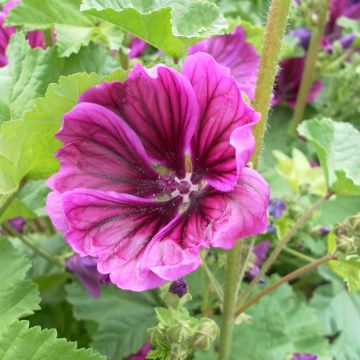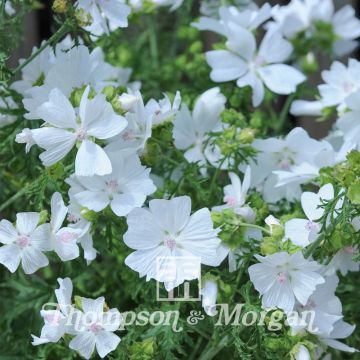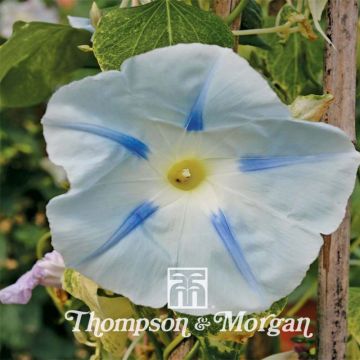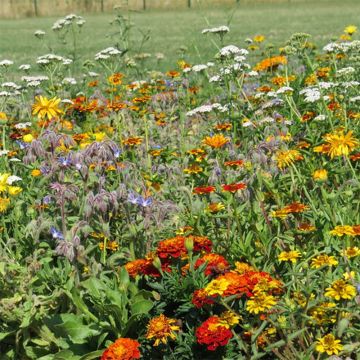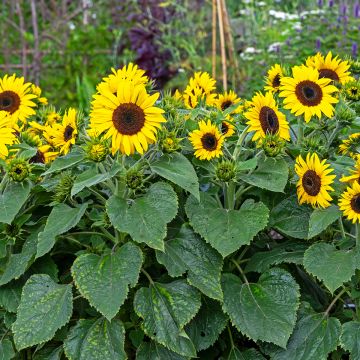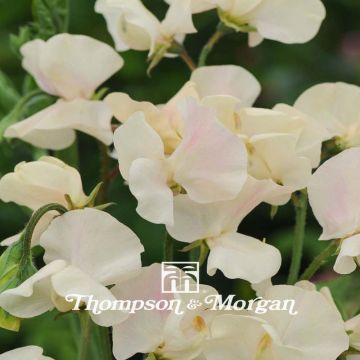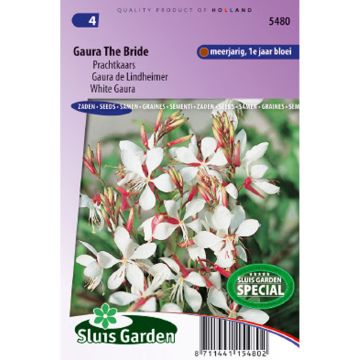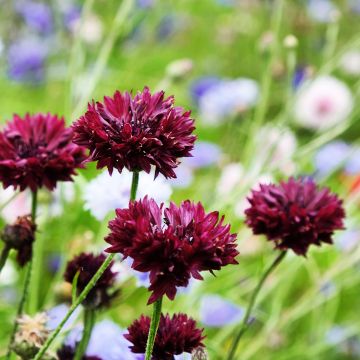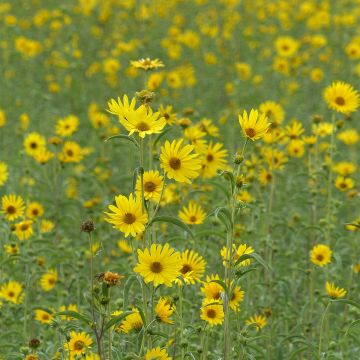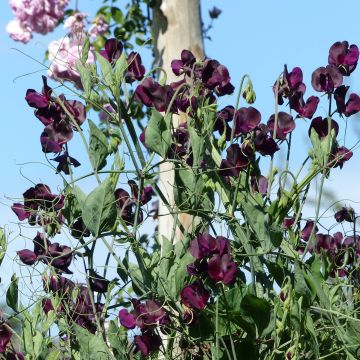

Malva Sylvestris Mystic Merlin 1 Packet
Malva sylvestris Mystic Merlin - seeds
Malva sylvestris Mystic Merlin
Common mallow, High mallow, Tall mallow
This plant carries a 6 months recovery warranty
More information
We guarantee the quality of our plants for a full growing cycle, and will replace at our expense any plant that fails to recover under normal climatic and planting conditions.
Seed-only orders are dispatched by sealed envelope. The delivery charge for seed-only orders is €3.90.
Does this plant fit my garden?
Set up your Plantfit profile →
Description
This eye-catching mix of Malva sylvestris Mystic Merlin is more biennial than perennial. These plants produce sturdy stems covered in purple, blue, violet and mauve flowers with elusive shades, deeply veined with darker flames, emerging from dark foliage reminiscent of ivy. This is an easy-to-grow plant in partial shade or full sun and offers a magnificent spectacle throughout the summer, even in the first year of cultivation. It is hardy, adapts to almost all soils, and tolerates drought.
Malva sylvestris is a medicinal plant native to sunny meadows and woodlands in Europe, Asia, and North Africa. It belongs to the malvaceae family, like the marshmallow (Althea officinalis) used by pharmacists. 'Mystic Merlin' is a selection of top-quality horticultural varieties. It is an erect biennial plant measuring 1.50 m (5ft) high when flowering and occupying 60 cm (24in) of space on the ground. It quickly forms a clump of large heart-shaped to rounded, dark green, slightly lobed, crenate and beautiful leaves. Flowering takes place from June to September depending on the sowing date. The flowers are grouped in well-distributed clusters on sturdy stems, displaying perfect architecture and chromatic harmony. Their 5-petaled notched corollas are adorned with various colours, from purple to violet, with intermediate shades like mauves or blues. Veins on the petals form a pattern resembling darker, tapering flames that plunge towards the heart of the flower. The flowers attract pollinating insects.
Wood mallow is ideal in natural areas, on large slopes, or in cottage gardens alongside hollyhocks, hybrid mulleins, or tall thistles.
Mallow is also a food plant. Its young leaves are consumed as a vegetable in Morocco, just like spinach, prepared with lemon juice. It is a delicious dish and useful for promoting intestinal transit. This plant is also known for soothing burns and digestive disorders. In Mediterranean cuisines, it is used raw in salads. Nowadays, it is used in the preparation of soothing balms.
Report an error about the product description
Flowering
Foliage
Plant habit
Botanical data
Malva
sylvestris
Mystic Merlin
Malvaceae
Common mallow, High mallow, Tall mallow
Cultivar or hybrid
Other Graines de Mauves
Planting and care
Sow the seeds of Mystic Merlin Great Mallow from late winter to early spring by burying them deep in rich compost. Make sure the soil is moist but not waterlogged and seal them in a polyethylene bag until germination, which usually takes 15 to 21 days at 21°C (69.8°F). Transplant when the plants are large enough to handle into 8 cm (3in) pots. Let them grow on in cooler conditions, then plant them in the ground in a not-too-rich soil, in the sun, spaced at least 40 cm (16in) apart.
Like all other species in the genus, this mallow can be prone to rust, which is more unsightly than truly harmful to the plant. It is wet conditions that promote the appearance of the disease. This small 'bush' is similar to lavatera but a little less hardy. It is best to prune it back every spring as you would for the latter. If you grow this plant in soil that is too rich in organic matter, it will tend to flop.
Sowing period
Intended location
-
, onOrder confirmed
Reply from on Promesse de fleurs
Flower seeds
Haven't found what you were looking for?
Hardiness is the lowest winter temperature a plant can endure without suffering serious damage or even dying. However, hardiness is affected by location (a sheltered area, such as a patio), protection (winter cover) and soil type (hardiness is improved by well-drained soil).

Photo Sharing Terms & Conditions
In order to encourage gardeners to interact and share their experiences, Promesse de fleurs offers various media enabling content to be uploaded onto its Site - in particular via the ‘Photo sharing’ module.
The User agrees to refrain from:
- Posting any content that is illegal, prejudicial, insulting, racist, inciteful to hatred, revisionist, contrary to public decency, that infringes on privacy or on the privacy rights of third parties, in particular the publicity rights of persons and goods, intellectual property rights, or the right to privacy.
- Submitting content on behalf of a third party;
- Impersonate the identity of a third party and/or publish any personal information about a third party;
In general, the User undertakes to refrain from any unethical behaviour.
All Content (in particular text, comments, files, images, photos, videos, creative works, etc.), which may be subject to property or intellectual property rights, image or other private rights, shall remain the property of the User, subject to the limited rights granted by the terms of the licence granted by Promesse de fleurs as stated below. Users are at liberty to publish or not to publish such Content on the Site, notably via the ‘Photo Sharing’ facility, and accept that this Content shall be made public and freely accessible, notably on the Internet.
Users further acknowledge, undertake to have ,and guarantee that they hold all necessary rights and permissions to publish such material on the Site, in particular with regard to the legislation in force pertaining to any privacy, property, intellectual property, image, or contractual rights, or rights of any other nature. By publishing such Content on the Site, Users acknowledge accepting full liability as publishers of the Content within the meaning of the law, and grant Promesse de fleurs, free of charge, an inclusive, worldwide licence for the said Content for the entire duration of its publication, including all reproduction, representation, up/downloading, displaying, performing, transmission, and storage rights.
Users also grant permission for their name to be linked to the Content and accept that this link may not always be made available.
By engaging in posting material, Users consent to their Content becoming automatically accessible on the Internet, in particular on other sites and/or blogs and/or web pages of the Promesse de fleurs site, including in particular social pages and the Promesse de fleurs catalogue.
Users may secure the removal of entrusted content free of charge by issuing a simple request via our contact form.
The flowering period indicated on our website applies to countries and regions located in USDA zone 8 (France, the United Kingdom, Ireland, the Netherlands, etc.)
It will vary according to where you live:
- In zones 9 to 10 (Italy, Spain, Greece, etc.), flowering will occur about 2 to 4 weeks earlier.
- In zones 6 to 7 (Germany, Poland, Slovenia, and lower mountainous regions), flowering will be delayed by 2 to 3 weeks.
- In zone 5 (Central Europe, Scandinavia), blooming will be delayed by 3 to 5 weeks.
In temperate climates, pruning of spring-flowering shrubs (forsythia, spireas, etc.) should be done just after flowering.
Pruning of summer-flowering shrubs (Indian Lilac, Perovskia, etc.) can be done in winter or spring.
In cold regions as well as with frost-sensitive plants, avoid pruning too early when severe frosts may still occur.
The planting period indicated on our website applies to countries and regions located in USDA zone 8 (France, United Kingdom, Ireland, Netherlands).
It will vary according to where you live:
- In Mediterranean zones (Marseille, Madrid, Milan, etc.), autumn and winter are the best planting periods.
- In continental zones (Strasbourg, Munich, Vienna, etc.), delay planting by 2 to 3 weeks in spring and bring it forward by 2 to 4 weeks in autumn.
- In mountainous regions (the Alps, Pyrenees, Carpathians, etc.), it is best to plant in late spring (May-June) or late summer (August-September).
The harvesting period indicated on our website applies to countries and regions in USDA zone 8 (France, England, Ireland, the Netherlands).
In colder areas (Scandinavia, Poland, Austria...) fruit and vegetable harvests are likely to be delayed by 3-4 weeks.
In warmer areas (Italy, Spain, Greece, etc.), harvesting will probably take place earlier, depending on weather conditions.
The sowing periods indicated on our website apply to countries and regions within USDA Zone 8 (France, UK, Ireland, Netherlands).
In colder areas (Scandinavia, Poland, Austria...), delay any outdoor sowing by 3-4 weeks, or sow under glass.
In warmer climes (Italy, Spain, Greece, etc.), bring outdoor sowing forward by a few weeks.

































